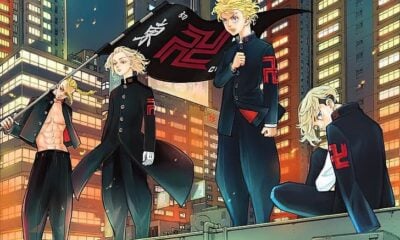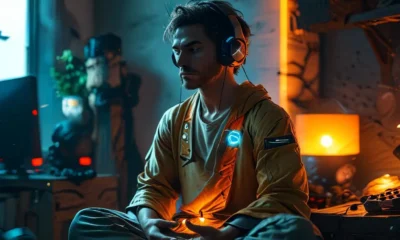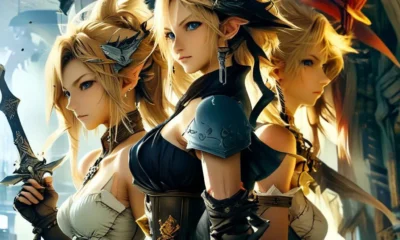Features
Walking Within Visions of Gothic and Cosmic Horror in ‘Bloodborne’
From Software’s Bloodborne, a Souls series spin-off, is perhaps one of the most fully, aesthetically and atmospherically, realized games that I have had the pleasure to come across within my lifetime.
Personally, I consider Bloodborne to be the best adaptation of Lovecraft’s themes I have ever seen; instead of using Cthulhu memes to imply a superficial and easy-to-understand weirdness, there’s actual depth, and results of the horrors that can come forth from the human mind are built and available, with all their complexities, as a world to walk within.
Wandering through some of the landscapes in Bloodborne feels like stepping forth on the flesh of a madman’s brain, though slowly sinking in quicksand in the process.
The surface of this madness is tinged with Gothic horror– of sickly plagued men with burning torches, lycan beasts, blood-hungry vampiric humans, an old village of witches tucked away beyond a looming forest and other such, usually sanguinolent, things.
The complimentary nature of all elements is evident from the title screen to the end credits. Nothing is out of place. Upper Cathedral Ward (with its tremendous choir) and The Fishing Hamlet are strikingly different, but they obviously belong to the same world.
These kind of visual and thematic ideas gradually evolve into different incarnations as you progress from one area to another.
With all the beautiful intricacies of this world’s setting, simply pressing the SHARE button doesn’t do the game any justice, nor does it rightly represent my time in Yharnam.
As such, my method of capturing images in Bloodborne is more in line with the idea of witnessing events and places from the perspective of my player character. I want to capture the Yharnam my character walks within, beyond the overlaid menu and button prompts. Post-play, I can stitch together visuals of this world and appreciate every fine detail in a way not always possible when you’re actively playing and have to be aware of things that might suddenly attack you.
The good ol’ “hide HUD and use binoculars/monocular” trick that I’ve come to know in Souls game was what I utilized here to achieve this first-person perspective (though with the added step that requires you to use the “sit down” gesture).
In a way, it’s like using a very limited in-game camera. These limitations, however, are what also, at times, inspire focused outcomes.
Adapting Lovecraftian cosmic horror themes is nothing new in games, and dying worlds telling tales of the past is a common trait in the Souls series. But to utilize it in such a context where the dreamscape atmosphere of it all oozes, or rather bleeds, into the actual experience of playing the game is pretty unique.
Via visual storytelling, Bloodborne writes the perfect epitaph for the world in which you now hunt; a world that, unlike the worlds in Souls games, is not yet dead but is instead in the process of dying.
Throughout my, now countless, playthroughs, each time I enter Yharnam, it feels as if I have arrived at a location that may actually exist. Each area naturally (and then unnaturally) transitions into the next in a way that the reminds me of the first Dark Souls title, but in a more, at times, abstract and metaphysical level.
The Chalice Dungeons too, while a little more removed from the rest of the game’s setting, have an unsettling allure that isn’t misplaced.
These dungeons seem to not exist in the “real world” (or dream world?) of the rest of the game, but rather as endless tunnels representing the buried, secret history of Yharnam’s ancestors, the Pthumerians.
Whether it’s time travel or going through a dream-like recollection of the past, venturing into this underground dimension brings a different ambiance to the game while still feeling like a well-suited part of a whole. I remember the awe and wonder that came over me as I ventured into the deeper layers of these dungeons, especially in the Isz Chalice Dungeons, where fog, that looks like bursts of outer space, weaves through alien and plant-like infested ruins.
Others have accomplished insightful reads into the inspirations that, at least on a basic level, make Bloodborne what it is. I’m not a fan of over-analyzation of the alleged meanings of the game’s narratives, opting to enjoy the game as it is presented to me, and learn about the external influences that created this game that I hold in such high esteem.
The best I can do, in that regard, is take pictures that highlight the things I love the most about Bloodborne, which is just about everything really.
(All images featured in this article were taken by the author)
Full gallery of images:

-

 Features4 weeks ago
Features4 weeks agoDon’t Watch These 5 Fantasy Anime… Unless You Want to Be Obsessed
-

 Culture3 weeks ago
Culture3 weeks agoMultiplayer Online Gaming Communities Connect Players Across International Borders
-

 Features3 weeks ago
Features3 weeks ago“Even if it’s used a little, it’s fine”: Demon Slayer Star Shrugs Off AI Threat
-

 Features2 weeks ago
Features2 weeks agoBest Cross-Platform Games for PC, PS5, Xbox, and Switch
-

 Game Reviews4 weeks ago
Game Reviews4 weeks agoHow Overcooked! 2 Made Ruining Friendships Fun
-

 Game Reviews4 weeks ago
Game Reviews4 weeks agoHow Persona 5 Royal Critiques the Cult of Success
-

 Features3 weeks ago
Features3 weeks ago8 Video Games That Gradually Get Harder
-

 Features1 week ago
Features1 week agoThe End Is Near! Demon Slayer’s Final Arc Trailer Hints at a Battle of Legends
-

 Features2 weeks ago
Features2 weeks agoDon’t Miss This: Tokyo Revengers’ ‘Three Titans’ Arc Is What Fans Have Waited For!
-

 Uncategorized3 weeks ago
Uncategorized3 weeks agoSleep Meditation Music: The Key to Unwinding
-

 Guides2 weeks ago
Guides2 weeks agoHow to buy games on Steam without a credit card
-

 Game Reviews2 weeks ago
Game Reviews2 weeks agoFinal Fantasy VII Rebirth Review: A Worthy Successor?






















